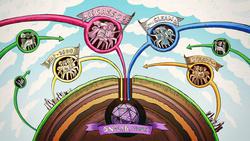Voyage to SNOLAB

A growing number of scientists are looking for ways to join a dream team of experiments in a unique laboratory a mile and a half underground in Ontario. There, they seek to solve some of the biggest mysteries in physics today, including the case of missing dark matter.
The story of how SNOLAB came to be begins about 1.8 billion years ago. That’s when it is believed that a meteorite crashed in Ontario, leaving an oval scar between 20 and 40 miles in diameter that is still visible via satellite today. The impact left a crater filled with magma, which crept into cracks in the rock. The magma hardened into deep veins of precious metals and minerals and solidified the area’s future as a mining town.
Scientists on experiments at SNOLAB wait for particles such as dark matter or neutrinos to bump into atoms in their detectors. When one of these tiny collisions occurs, it releases a small amount of energy that the detector picks up as a signal. On the surface, cosmic-ray particles fall in a constant barrage from space, collide with the sensitive detectors and obscure the signals physicists actually want to find. Deep underground, layers of protective rock shield experiments from this distracting extraterrestrial sleet.
By Kathryn Jepsen
Image courtesy of Symmetry Magazine, a joint Fermilab/SLAC publication